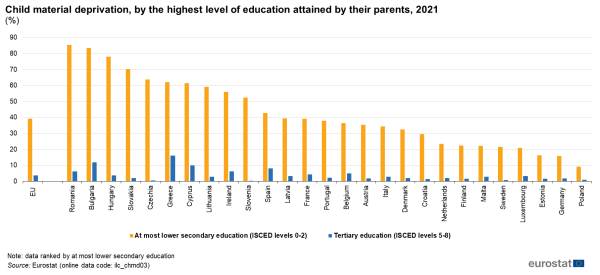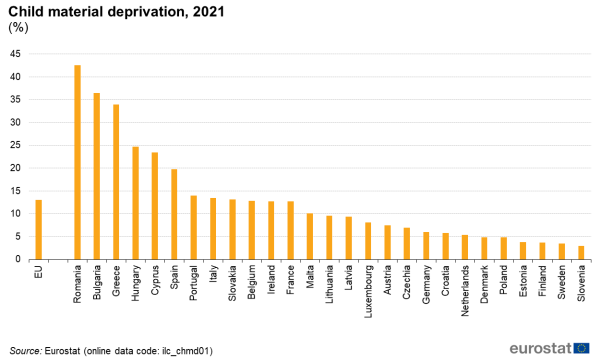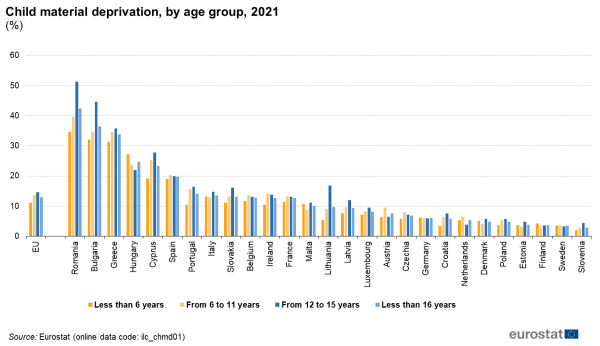Children - material deprivation
Data extracted in April 2023
Planned article update: February 2026
Highlights
Child material deprivation, 2021
This article presents statistical data on the situation of children (aged less than 16 years) in the European Union (EU) who were materially deprived in 2021. Material deprivation is defined as an enforced lack of at least three items from a set of 17 items (12 child-specific and 5 household-specific). The analysis compares children of different age groups and examines the impact of their parents' educational level. All figures are based on EU statistics on income and living conditions (EU-SILC) available from Eurostat’s online database. EU-SILC data are available for all EU Member States.
Full article
Key findings
In 2021, 13.0 % of children (aged less than 16 years) in the EU were materially deprived. The highest rate was recorded for children aged 12-15 years old – 14.6 % compared with 11.1 % for children aged under six.
One of the factors influencing material deprivation of children in the EU in 2021 was parents’ level of education. 39.1 % of children whose parents’ level of education was low experienced material deprivation compared with 3.8 % of children whose parents’ level of education was high.
Child material deprivation by age groups
In 2021, at EU level, the child material deprivation rate was highest in the age group 12-15 years and lowest among children aged under six (14.6 % as compared with 11.1 %). This pattern was repeated in 12 out of the 27 EU Member States, with the highest differences recorded in Romania (16.6 percentage points), Bulgaria (12.6 percentage points) and Lithuania (11.5 percentage points)(see Figure 2).
Level of education of the parents
One of the factors that affects material deprivation of children (further to the reducing effect that targeted social transfers can have) is the level of education of their parents, which is largely linked to their labour market situation.
Children whose parents attained a lower educational level are more likely to experience material deprivation compared with children whose parents attained a higher education level. An adult’s education level affects the type of job an individual can access. Generally, the lower the level, the higher the risk is for the individual and for the household, including children, to experience material deprivation compared with those with a higher educational level.
In 2021, 39.1 % of children in the EU living in a household whose parents had a low level of education of at most lower secondary (ISCED levels 0-2), were experiencing material deprivation. On the other hand, the respective rate for children living in the households whose parents had a high level of education (tertiary education, ISCED levels 5-8), was 3.8 % — see Figure 3. The child material deprivation gap for children based on the parents’ level of education — difference of child material deprivation rate between the highest and lowest levels of parents’ education — was therefore 35.3 percentage points. The gap among the EU Member States ranged from 8.2 percentage points in Poland and 13.9 points in Germany to 74.4 percentage points in Hungary and 79.0 percentage points in Romania. In 8 out of the 27 Member States the gap was above 50.0 percentage points.

Source: Eurostat (ilc_chmd03)
Source data for tables and graphs
Data sources
The data used in this article are derived from EU statistics on income and living conditions (EU-SILC). EU-SILC data are compiled annually and are the main source of statistics that measure income and living conditions in Europe; it is also the main source of information used to link different aspects relating to the quality of life of households and individuals.
Information on material deprivation specific to children was collected in 2021 as a part of the three-yearly variables on Children based on Commission Implementing Regulation (EU) 2019/2242. The reference population for the information presented in this article is all private households and their current members residing in the territory of an EU Member State (or non-member country) at the time of data collection; persons living in collective households and in institutions are excluded from the target population. The data for the EU are population-weighted averages of national data.
Context
The child specific deprivation rate is the percentage of children below 16 who suffer from the enforced lack of at least three items out of the following 17 (unweighted) items:
- Child: Some new clothes
- Child: Two pairs of shoes
- Child: Fresh fruits and vegetables daily
- Child: Meat, chicken, fish daily
- Child: Suitable books
- Child: Outdoor leisure equipment
- Child: Indoor games
- Child: Leisure activities
- Child: Celebrations
- Child: Invite friends
- Child: School trips
- Child: Holiday
- Household: Replace worn-out furniture
- Household: Arrears
- Adults in the household: Internet[1]
- Household: Home adequately warm
- Household: Car
Only children lacking an item for affordability reasons (and not by choice or due to any other reasons) are considered deprived of this item. Those lacking the item “for other reasons” are treated, together with those who have the item, as not deprived.
Educational attainment level is classified according to ISCED — the international standard classification of education. The (latest) 2011 version has the following levels:
Low level of education: • ISCED level 0 — early childhood • ISCED level 1 — primary education • ISCED level 2 — lower secondary education
Medium level of education: • ISCED level 3 — (upper) secondary education • ISCED level 4 — post-secondary non-tertiary education - medium level of education;
High level of education: • ISCED level 5 — short-cycle tertiary education; • ISCED level 6 — bachelor’s or equivalent level; • ISCED level 7 — master’s or equivalent level; • ISCED level 8 — doctoral or equivalent level.
The educational level of children’s parents is defined for this article as the highest level of education attained by one of the parents. For example, if father has a low level of education of at most lower secondary (ISCED "levels 0-2"), and mother has a medium level of education (upper-secondary education) (ISCED "levels 3-4") it is considered that the child’s parents have a medium level of education.
Direct access to
See also
Statistical articles
- Material deprivation statistics - early results
- Children at risk of poverty or social exclusion
- Living conditions in Europe - income distribution and income inequality
- Living conditions in Europe — online publication
- Migrant integration statistics — at risk of poverty and social exclusion
- Quality of life indicators — material living conditions
Methodological articles
Glossary item
Dedicated section
- Income and living conditions (ESMS metadata file — ilc_esms)
- Income and living conditions — information on data
- Income and living conditions — methodology
Notes
- ↑ If at least half of the adults in the household are deprived of this item, the child is considered deprived of the item.

